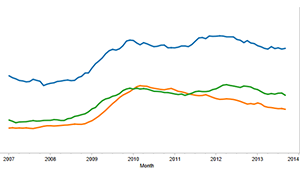Many demographic groups still struggling with limited gains from recession’s peak unemployment
Nov. 6, 2013 — When you’ve looked for monthly unemployment data, you have probably noticed that you can pretty readily find those data sliced by race or gender. Sometimes you can find the data arranged by age group or by educational attainment.
Three demographic composites at a time
Map & Data Resources
Resolution at least 1280 X 1024? Click here
But each of those dimensions — race or ethnicity, gender, age, and educational attainment — operates concurrently to create a discrete demographic composite. Each such composite has its own unemployment rate, and the the rates look very different from one another.
Last year, Remapping Debate created a striking new set of interactive tools to allow you to explore how each of these factors works together, and we now update the data every month. This analysis of October data was delayed by the government shutdown.)
What we do is analyze unemployment data from the Current Population Survey of the Census Bureau (the data that are used by the Bureau of Labor Statistics) from 2006 to the present — data for August 2013 (released in full by the Census Bureau’s Current Population Survey earlier this month) are now integrated. In order to account for seasonal variation and to reduce the margin of error, the results reported for each month represent a moving average of that month and the preceding 11 months. Thus, for example, the first month represented in the visualization is Jan. 2007, comprising a moving average of the months from Feb. 2006 through and including Jan. 2007.
While the 12-month moving average of the unemployment rate for every demographic composite has decreased from its highest point since the recession, many composites have made only limited gains.
In fact, out of the 260 demographic composites for which data was sufficiently reliable in September, 208 composites have recovered less than half of the ground lost since their pre-crash low point, in percentage point terms. Of those 208, 33 demographic composites have yet to recover 25 percent of the ground lost.
For example, the pre-crash low for Hispanic men between the ages of 16-25 with less than a high school degree was 10.6%. During the recession, the unemployment rate for this group rose dramatically to 26.7 percent. While it has since fallen to 22.9 percent, that decrease of 3.8 percentage points is only 23 percent of the way back to the group’s pre-crash low.
four demographic composites at a time
Map & Data Resources
Resolution at least 1600 X 1200? Click here
We have three flavors of the visualization, depending on your screen resolution. The one that appears directly below only requires a resolution of 1,024 x 768. It allows you to select two different demographic composites. If you want to compare and contrast three demographic composites at once, you need a screen resolution of at least 1,280 x 960, and you should click on the pop-up box to the left. If you want to compare and contrast four demographic composites at once, you need a screen resolution of at least 1,600 x 1,200, and you should click on the pop-up box to the right.
Note: We started with 300 demographic composites. When one of them had a standard error equal to 10 percent or more of the unemployment estimate for a 12-month moving average, that 12-month moving average does not appear in the visualization (you will see in a limited number of cases that the line that graphs change in unemployment rate over time is not complete). In those cases in which every month’s moving average was at or above our standard error threshold, you won’t be able to create the particular composite at all.
That said, there are more than 270 composites available. No 12-month moving average that is reported has a margin of error (+/-) of more than 4.5 percentage points (at a 90 percent confidence level). In most cases, that margin of error (+/-) is substantially less.
Along with the graph that tracks change over time, the visualization reports the overall average of unemployment for the entire period, the highest and lowest 12-month moving unemployment averages for the entire period, and the current 12-month moving average (September 2013 is the most recent reporting date).
Selected a composite, but no display appears? That’s because you’ve come upon a composite with too high a standard error. Select another composite!
On the next page, the data are organized in table form and allow you to sort each of the available demographic composites by average, highest, lowest, and current 12-month moving averages of unemployment.


